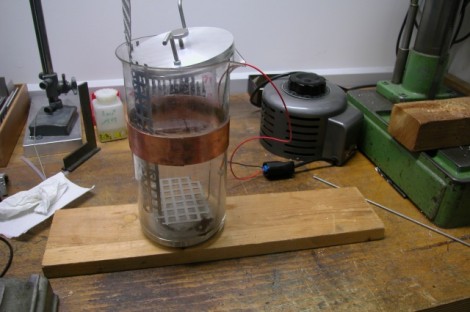
Ditch that old toaster oven and move to the next level of surface mount soldering with this vapor phase reflow method. [Ing.Büro R.Tschaggelar] put together this apparatus to use vapor phase reflow at his bench instead of sending out his smaller projects for assembly. It uses the heating element from an electric tea kettle to boil Galden HT 230 inside of a Pyrex beaker. There’s a copper heat break part way up the beaker to condense the chemical and keep it from escaping. When a populated board is lowered into the heated chamber, the solder paste reflows without the need to stress the components with unnecessary heat. Better than traditional reflow? At this level it’s hard to say, but we do find his method quite interesting.
[Thanks Chris]
















The website is geting Hackadayed…. aka ADDOS D:
(site is still down, as mentioned)
There is ‘unnecessary heat” and the is “necessary heat” – ie following the soldering paste heat profile is pretty essential to prevent bad joints, tombstoning etc… His method seems to be more of a “quick and dirty” approach…
http://www.ibrtses.com.nyud.net/projects/vapourphasesoldering.html
With the Vapour Phase method, there is no chance of overheating since the components can’t get hotter than the boiling point of the liquid.
The worst issue with it may be the cost and environmental impact of the fourocarbon-liquids.
Some dioles might be a substitute, like
http://en.wikipedia.org/wiki/1,4-Butanediol
Has anyone a better idea for a substitute, considering that you likely fall prey to agencies like the DEA or similar if you purchase Butanediol?
Still, you might have to consider the solvent properties or reactivity of the liquid. Might not be an issue if the PCB is immediately cleaned with isopropanol after pulling it out of the gas bath.
Pretty interesting project from a theory standpoint. I don’t know why so many people seem to have an issue with soldering SMD. At least not at the hobby level.
I did a LOT of SMD soldering in an R&D lab, and almost all of it was by hand. I used a butane torch once in a while. A regular Weller iron, fine solder (sometimes) and that was it. (And a magnifier!)
But this is cool for learning about a process, and maybe it can lead to something a lot of people that DO have issues with SMD can use.
You can use plain old water as the fluid, provided the system has enough pressure to raise the boiling point to 230 degrees C. Dissolved salts will raise the boiling point too. I’m not sure if steam causes any corrosion problems though.
@Rachel,
You’re a girl after my own heart, even though you’re not a girl and simply play one on TV.
Feet of clay, as it were. Or phosphorous.
Something like that.
Soldering with water as the fluid isn’t that great of an idea – 280F occurs around 4 atmospheres, and I think 270F is reachable in a standard pressure cooker at 2 atmospheres. To reach the temps you’re talking about would be pushing 830 inches of mercury, roughly 440 psi.
It’s doable, but why? :)
Soldering with steam isn’t practical because of the ease with which moisture will penetrate standard expoxy packages. I suppose you could do this and then bake it out again, but gosh, who has that kind of time.
Well, maybe you do…
http://www.youtube.com/watch?v=oyQUvMT7tAw
there has to be a way to make this bigger, us 360 and ps3 owners would be able to do much easier reflows :)
This reminds me of something I was thinking the other day, how come that to make a PCB we still need to either use a service or if we do it at home we need all those awful chemicals that are also hard to get rid off, why is there no development in that area, we use processes that have not changed since the invention of circuitboards, can’t they make some sort of polaroid-like system at least?
Or rethink the whole thing from the ground up, release a printer that has copper ink or something? Or a laserprinter that uses some copper (or more modern conductive compounds?) ink system.
Technology has developed in every other area, and material science has come a long way, there must be a way to make the whole thing convenient, one that actually is not just working in a limited way in some rendered picture on some corporate site under the header ‘one day – maybe’
But I guess there too some amateur has to design something and hoping for the techsector to wake up is a hopeless endeavor.
/semi-rant
My father created and sold this kind of things 20 years ago with his company which was called “fluochimie”.
It is sure the best way to solder things without stressing components:
3 advantages:
The heating is very quick.
You cannot get higher in temperature(for the components) than the liquid boiling temperature.
The quality of brazing is a lot higher than with traditional reflowing since heat is homogenous inside the vapor.
The liquid he used back then was GALDEN(if I remember well) which is an inert liquid (fluor inside).
Since vapor is heavier than air,the vapor stay at the bottom of the recipient (i’m french so sorry for my bad english)
There’s one problem though:You have to keep the heating resistors with a temperature under the liquid degradation temperature.If the liquid get higher temperature it will become highly toxic,and you sure do not want to die.
@Guillaume
Do you happen to live in or near 92?
@whatnot
actually, plotted conductive ink pcbs have been done but the applications aren’t usually worth the effort except for one off prototypes. flexible and paper pcbs introduce other problems, and plotting to fiberglass isn’t useful. Same for teflon, any good pcb material requires chemical prep to be durable.
Most of the conductive inks are silver based. It’s great if you need a flexible thin pcb made of mylar/paper, but it’s limited to things that need antennas or wacky geometry.
Conductive toners pose a different problem. Since laser printers use electrostatic charges to distribute the toner to the paper, conduction makes that job a lot harder. Basically, for this to work in conventional process laser printers, the toner would need to be activated during or after the heat step.
It’s possible to find conductive fluids that bind to toner after the transfer, but the extra steps make this method more painful than the usual method of printing the conductive part of the PCB onto an intermediate film and then heat transferring it to the pcb material.
You still have to etch, but etching is easier than making the toner conductive and then dealing with the fragility of carbon based materials. Finally, none of these processes help if you need holes or cutouts.
Even the laser based PCB making processes suck because of alignment and penetration issues – you can do it, but the cost is higher.
The next big development will be faux biological creation of pcbs and assembliesd, but you won’t be building radio transmitters or high-speed number crunchers. Well, not very good ones, if the sodium ion transmission techniques can’t be improved upon. And if God hasn’t pulled that trick off in the last 5,000 years, who can?
;)
Whatnot, you can always mill PCBs on a mini-mill at that scale…
@bilbao bob
So bind the conductive stuff to a meltable catalyst of some sort and make it so you can heat it in your oven or dip it in vinegar or something and have it bond strongly to substrate.
I didn’t say i knew the fix but more that with all we know by now there should be a more modern way.
Incidentally bilbao bob, slightly off-topic but since you are know to be concerned, did you see this?
http://www.foxnews.com/scitech/2010/10/13/government-spying-social-networks/
Even wikipedia? Geez
how do i get my 360 in that little container :)
that project was last updated in 2006??
has anybody tried to use a laser for a heat source?
@whatnot
Nothing about government has changed in at least three millenia, so I think we can pretty much assume surveillance will always be permissable and actively used to the utmost extent allowed by available technology.
I mean, we’re all gonna get chipped whether we like it or not, within one generation, barring “unforseen events”. It doesn’t even bother me.
Decorative fictions like the constitution and the “universal declaration of human rights” have pretty much been advertising and fairy tales for the rubes from the beginning. We’re taught that just because a bunch of wealthy aristocrats managed to leverage “higher taxes, unpopular wars and internal conflict” into briefly getting control of the government in 1215, we’re all free.
But it’s simply not true. The Magna Carta was about as significant to humanity’s future as was the bible – believers believed, haters hated and everyone else went on about their business.
But the magna carta became little more than an inspirational historical fairy tale, just as we see with the constitution, the declaration of independence (damnable british kept getting in the way of George W’s ability to sell whiskey!) and the ten commandments. I figure it’ll take the true believers of the desert religion a little longer to forget what the fuss was all about, but it’ll happen. You see, they believe in something, and that always makes for a bit of a mess for those of us who are part of the established order of things. Give it time. It’ll pass.
Anyway, they can surveil away! All I care about is that I can’t get my own details delivered by email every day in summary form so that I can account for my own whereabouts.
It’ll get here, but not soon enough for me.
Yeah even I think Vapor Phase Reflow soldering is the best method for heating because with this method there is a low chance of overheating.
HI ! my name is guess
i had play vapor soldering one year . But i don’t know what the pressure and the temp is really difficult to balance .
How to calculate the volume about the galden after been heat !